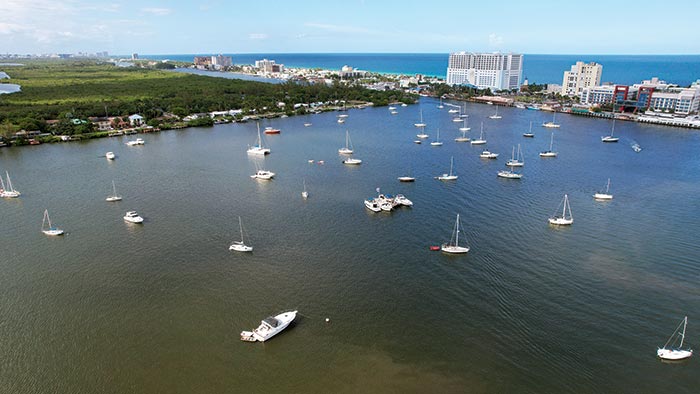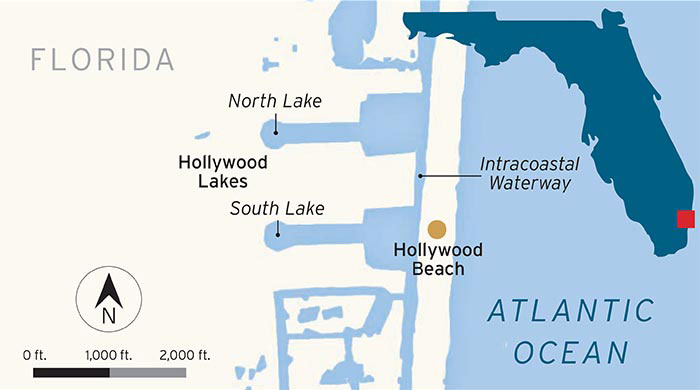Advertisement
Much-needed anchoring rules will help address a transient layover problem at one popular Florida destination. BoatUS is pushing other municipalities to follow suit.

Florida's North Lake in Hollywood may look like a mooring field but, until recently, boaters could anchor pretty much indefinitely. (Photo: Rick Legow)
Among the approximately 12 million recreational boats registered in the U.S., nearly 1 million (or 8%) reside in Florida — more than any other state. Mix that many boats with the Sunshine State's year-round boating climate, and the result is that Florida has the most derelict, at-risk, and abandoned boats by state (nearly 600 officially, but probably many more). Now let's introduce the tens of thousands of waterfront property owners who also want a nice view, and you can see how the evolving push-pull battle over anchorage rights in the state has intensified.
With that in mind, BoatUS supports a Broward County ordinance approved in November that establishes anchoring limitations specific to both North and South lakes within Hollywood, located about 10 miles south of Fort Lauderdale. The new ordinance allows anchoring for 45 days within any six-month period, including an exemption for imminent or existing hazardous weather conditions.
"We believe 45 days is a reasonable time frame for a vessel to remain in a particular area and will allow all active, responsible cruising and recreational boaters to use, anchor, rest, repair, visit, reprovision, and enjoy these bodies of water," says David Kennedy, manager of the BoatUS Government Affairs team. Among more than 800,000 BoatUS members, nearly 180,000 call Florida home, but many snowbird cruisers and Great Loopers from the north seasonally migrate to and through the state.
The ordinance is specific to both of the similar man-made North and South lakes. Both open into the Intracoastal Waterway, which can be transited to Fort Lauderdale or Miami, and into the Atlantic Ocean. But the lakes have traditionally been used differently. North Lake is an idle-only area — home to Gulfstream Sailing Club as well as other nonpowered water activities such as rowing, kayaking, and canoeing. South Lake, on the other hand, is used for powered water activities such as skiing, tubing, and personal watercraft. The lakes had been bustling with a variety of watercraft until recent years because of the dramatic increase in derelict, at-risk, and storage boats anchored for months and even years at a time.

"I've been on these waters since the 1980s, and until the last seven years or so, they were recreational lakes where everyone had access to them for kayaking to personal watercraft to waterskiing to cruisers," says Rick Legow, a longtime BoatUS member and both a fervent boater and waterfront property owner on North Lake. "Suddenly, these almost permanently anchored vessels are coming in and making it impossible to safely do other boating activities. Many of these boats are no longer capable of propulsion, they aren't maintained, and some sink or break free. Half of them don't have lights and are parked outside a designated anchorage, so that's a safety hazard. These irresponsible vessel owners are squeezing out responsible boaters, and it's changed the whole complexion of the lakes."
When the remnants of Hurricane Ian swept over South Florida last September, several of these boats broke loose and damaged boats and property. Legow says at least eight ended up wrecked against the seawall and shores. "Who knows what they're anchoring with?" he asks. "We have several permanent raft-ups of four or five boats tied together and going nowhere."
Kennedy points to 2009 when several changes were made to Florida law that limited local governments from regulating anchoring. Cities and counties were expressly forbidden to "enact, continue in effect, or enforce any ordinance or local regulation ... regulating the anchoring of vessels other than liveaboard vessels outside the marked boundaries of mooring fields," under the law. Boaters who use their boats for navigation (even if only occasionally) could not be restricted from anchoring by a local jurisdiction (city or county) outside of permitted mooring fields. BoatUS supported the change in state law that also included a pilot program to allow five local governments to develop anchoring regulations with the input of all stakeholders.
"We were seeking a balance between consistent anchoring rules and appropriate local management of waterways," notes Kennedy. The pilot program ended in 2017 without any recommendations for how the interest of cruising boaters to have secure anchorages could be balanced with local interests in keeping their waterways open for all types of boating.
Advertisement
In the years that followed the 2009 legislation, boat-centric communities like Hollywood, Fort Myers, Merritt Island, and Tampa saw an influx of boats that moved into the neighborhood and sometimes never left. Legow counts 40 to 50 such boats in busier North Lake, and 10 to 12 in South Lake, which were both previously popular watersports areas.
Legow was part of a local coalition of boaters, property owners, and BoatUS that pressed state legislators to address the growing problem.
"We were told by local officials that their hands were tied. I reached out to BoatUS to see how we could find a way to stop these boats that never move from overwhelming our waterways, while still making space for active cruising boaters to anchor."
This resulted is a bipartisan bill passed in 2021 sponsored by Florida State Sen. Tina Polski and State Rep. Wyman Duggan that allowed for the creation of anchoring limitation areas that need to adhere to specific criteria.
"Rep. Duggan and Sen. Polski deserve the credit for working with BoatUS and other cruising groups to strike the right balance on managing these areas," notes Kennedy.
The Hollywood anchoring ordinance is the first action at the local level since the revised anchoring limitation areas were put in place. "We anticipate there will be other counties in Florida that will take a look at places where they need more management," Kennedy says. "BoatUS will work with them to find the right balance."
For now, appropriate signs and markings will be put in place in North and South lakes to make cruising boaters aware of the anchorage limitation areas and the limits it places on remaining in the areas.
"Hollywood is a good example of what can go wrong when local governments are limited in how they can manage our shared waterways," is how Legow sees his local waters, particularly when it comes to safety in a state that is more vulnerable in hurricane season.
